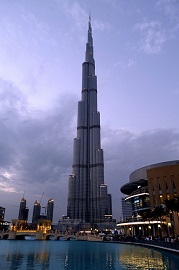Top Architectural Wonders of Dubai
Contents |
[edit] Introduction
Dubai is known for its modern, creative buildings that can be erected quickly and stand out from the crowd in terms of size and design. Some of these architectural wonders have been awarded accolades for their creative design, green credentials and all-round approach.
Below are some of the best.
[edit] Burj Khalifa
The tallest building in the world is over 160 storeys high (829 metres) and is located in Dubai. The Burj Khalifa is a top tourist attraction in the area and the building's architecture has been cleverly assembled, giving its stature. Started in 2004 and completed in 2010, the tip of the spire of the Burj Khalifa can be seen from 95 kilometres away, making it one of the most prominent buildings in the area. You can visit one of the viewing decks and look out on the city skyline – a beautiful sight. This building was built with the need to be recognised internationally, and its amazing architecture now makes it stand proud as one of the most well-known buildings in the world.
[edit] Atlantis, The Palm
Atlantis, The Palm is a beach resort hotel on the man-made Palm Island. The building is based around the myth of Atlantis. Opened by Sol Kerzner in 2008, this building contains 1,539 rooms, 23 restaurants and a nautical-themed water park, amongst other features. There are two towers, referred to as East and West and they are joined together by the Royal Bridge Suite. The architects for this beautiful 23-storey project were from the international firm Wimberly, Tong and Goo.
For more information, see Atlantis, The Palm.
[edit] Cayan Tower
Cayan Tower is also known as the Infinity Tower and is recognised for its interesting twisting shape. It is 306 metres high and was designed by Skidmore, Owings and Merrill (SOM). What makes this building so interesting is the twist itself, which twirls the building around by 90 degrees. Opened in 2013, this fairly new architectural wonder is extremely modern inside and out, filled with Dubai offices and apartments.
[edit] Burj Al Arab
The Burj Al Arab is the third tallest hotel in the world, behind the Rose Rayhaan and the JW Marriott, both also based in Dubai. This establishment rises 280 metres into the sky and stands on its own artificial island, connected to the mainland by a bridge. The architecture of this building is most definitely original, as the idea was for it to look like a relaxed sail of an Arabian ship, called a “dhow”. Led by famous architect Tom Wright, this building was created by 2,000 construction workers and brought to life by over 60 managers and designers – a true architectural feat.
For more information, see Burj al Arab, Dubai.
[edit] Related articles on Designing Buildings Wiki
- 7 Engineering Wonders of the world.
- 9 of the world’s most impressive structures.
- Atlantis, The Palm.
- Bridges of the world.
- Building of the week series.
- Burj al Arab, Dubai.
- Hyperloop in Dubai.
- India needs to build more infrastructure fast. Here’s how.
- Shanghai Tower.
- Tallest buildings in the world.
- The Gherkin.
- Top 10 most expensive construction projects in the world.
- Top 10 skyscrapers located in the UAE.
- Skyscraper.
- Wasl Tower.
Featured articles and news
Homes England creates largest housing-led site in the North
Successful, 34 hectare land acquisition with the residential allocation now completed.
Scottish apprenticeship training proposals
General support although better accountability and transparency is sought.
The history of building regulations
A story of belated action in response to crisis.
Moisture, fire safety and emerging trends in living walls
How wet is your wall?
Current policy explained and newly published consultation by the UK and Welsh Governments.
British architecture 1919–39. Book review.
Conservation of listed prefabs in Moseley.
Energy industry calls for urgent reform.
Heritage staff wellbeing at work survey.
A five minute introduction.
50th Golden anniversary ECA Edmundson apprentice award
Showcasing the very best electrotechnical and engineering services for half a century.
Welsh government consults on HRBs and reg changes
Seeking feedback on a new regulatory regime and a broad range of issues.
CIOB Client Guide (2nd edition) March 2025
Free download covering statutory dutyholder roles under the Building Safety Act and much more.
Minister quizzed, as responsibility transfers to MHCLG and BSR publishes new building control guidance.
UK environmental regulations reform 2025
Amid wider new approaches to ensure regulators and regulation support growth.
BSRIA Statutory Compliance Inspection Checklist
BG80/2025 now significantly updated to include requirements related to important changes in legislation.


























